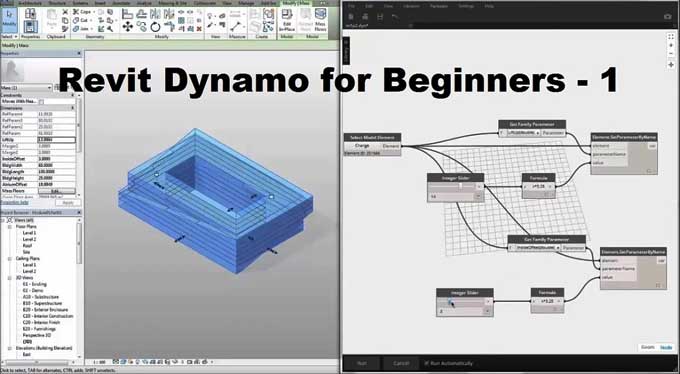The Ultimate Guide to Dynamo for Revit
Tweet
For young professionals, the choice of a visual programming software can be difficult because of the abundance of software available for architects today.
Doing research and reading reviews can help them make their decision. It's also important to consider their specific needs and the cost of the software. Ultimately, the best software for them is the one that meets all of their requirements, and that is when the Revit Dynamo comes to play.
Design and construction professionals have created an open source visual programming software called Dynamo. The topic of this blog is Dynamo, an Autodesk Revit plugin.
Dynamo for Revit
Revit Dynamo is a very potent visual scripting plugin for Autodesk Revit that gives regular users unparalleled access to the Revit API (Application programming interface).
With Dynamo, users can create custom scripts to automate otherwise tedious tasks, allowing them to save time and increase efficiency. It also allows for complex data manipulation that would be difficult to achieve manually. Dynamo is a great tool for streamlining workflow and thus making Revit more powerful.
The program is not a stand-alone solution; it interacts with Revit to provide computational building information modeling (BIM). The fact that Dynamo for Revit does not require prior programming experience is a significant benefit.
You may enter nodes from an algorithm as well as lines of code using Revit Dynamo. It provides a number of benefits that enhance the project design and operation processes. The program features a simple user interface and a variety of ready-made programming libraries.
Features Dynamo for Revit
The Revit Dynamo programming language helps users create and automate complex design workflows within the Autodesk Revit environment. Some of the key features of Revit Dynamo include:-
1. Users of Revit Dynamo may design unique workflows and automation processes by dragging and dropping components on a visual programming interface.
2. Users have the ability to design their own unique nodes that they may employ in their processes, giving workflows more personalization and flexibility.
3. Users of Revit Dynamo may control the data inputs and outputs at each stage of their workflow, simplifying the tracking and administration of modifications.
4. As Revit Dynamo and Autodesk Revit are completely connected, customers may quickly import and export data between the two applications.
5. Several people may collaborate on a project using Revit Dynamo, and each user has the ability to monitor and change the same processes in real-time.
6. In addition to Revit Dynamo's native functionality, it can be extended with third-party plug-ins.
7. A variety of operating systems, including Windows and MacOS, can be used with Revit Dynamo.
Uses of Dynamo
Architecture and engineering professionals can benefit from Revit Dynamo by modeling and analyzing complicated geometries, automating tedious tasks, reducing human error, and exporting data to Excel and other file types not generally supported by Revit.
In addition, Revit Dynamo can be used to quickly iterate on design ideas and test various solutions, allowing for faster decision-making and better-informed solutions. It also enables the rapid creation of drawings, simplifying the process of creating and archiving design documentation.
Designers may use Dynamo to speed up the design process, and by incorporating Dynamo to Revit workflow ideas into the project's execution, data input and repetitive labor can be reduced to increase productivity and efficiency across all disciplines and throughout all project phases.
Here are some uses of Dynamo for Revit:-
Managing repetitive activities
Consider performing any monotonous, repetitive operation, such as moving 100 files from one folder to another and renaming them with the current date. You could automate these duties by building a piece of code for it, freeing up your time to focus on more engaging and worthwhile projects.
Automating this tedious task could save you hours of time. Additionally, automation eliminates the possibility of human error and ensures that the task is completed accurately and quickly.
The project's BIM process and details contain a number of time-consuming and repetitive procedures that take many hours to complete. But, the effort is decreased and time and energy are greatly reduced by using BIM Automation technology.
For generating graphical output
One of the key advantages of using this Dynamo for Revit is that it can be used to create graphs that are clean and succinct so that team members can utilize them easily.
This makes the process of analysis and decision-making more efficient. It also makes it easier for team members to understand the data and identify the relationships between different elements. Dynamo for Revit can also be used to automate complex processes and reduce manual work.
The program assists in choosing every component in a certain category, reporting a parameter, and exporting to Excel with headers. With this, data output may be managed rapidly for use in evaluation.
To get online demonstration, watch the following video tutorial.
Video Source: TheRevitKid
Dynamo can also used in parametric modeling
Additionally, Dynamo for Revit is a powerful design tool, and you can explicitly describe the generative design rules with Dynamo, so the design becomes a process. With these rules, you can also generate hundreds of options.
This allows the user to quickly evaluate alternatives and find the optimal solution for their design criteria. This process also increases efficiency and reduces the amount of time needed to make decisions. The end result is an optimized design that is tailored to the user's specific needs.

Gallery
Feel free to contact us for BIM requirements. One of our representative will respond you within 24 Hours. Send us your projects requirement today and grow your project.
Explore More !







